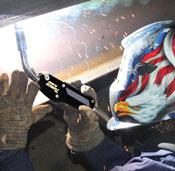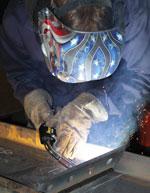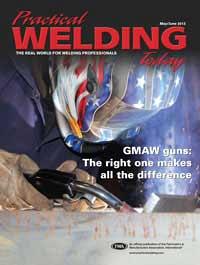Senior Brand Manager
- FMA
- The Fabricator
- FABTECH
- Canadian Metalworking
Categories
- Additive Manufacturing
- Aluminum Welding
- Arc Welding
- Assembly and Joining
- Automation and Robotics
- Bending and Forming
- Consumables
- Cutting and Weld Prep
- Electric Vehicles
- En Español
- Finishing
- Hydroforming
- Laser Cutting
- Laser Welding
- Machining
- Manufacturing Software
- Materials Handling
- Metals/Materials
- Oxyfuel Cutting
- Plasma Cutting
- Power Tools
- Punching and Other Holemaking
- Roll Forming
- Safety
- Sawing
- Shearing
- Shop Management
- Testing and Measuring
- Tube and Pipe Fabrication
- Tube and Pipe Production
- Waterjet Cutting
Industry Directory
Webcasts
Podcasts
FAB 40
Advertise
Subscribe
Account Login
Search
8 criteria for choosing the right GMAW gun
Application requirements and operator preference are key
- By Ross Fleischmann
- May 6, 2013
- Article
- Arc Welding
Even the most experienced and talented welding operator requires the right tools to do the job well. To optimize weld quality, it’s important to carefully select all the tools involved, from the welding power source to the accessories. For gas metal arc welding (GMAW), the right gun can be critical in ensuring an efficient and properly functioning system.
With so many guns available, it may be confusing to know which is the best option. A determining factor is whether you’ll need the gun for one specific application with fairly consistent parameters or for a variety of projects. If you plan to use the gun for more than one welding application, you may want to consider a model with a wide range of abilities.
At the heart of your decision should be comfort. Gun weight, heat dissipation, shape, hand positioning, and trigger configuration all contribute to your experience. Although you may purchase welding guns based solely on cost and basic application needs, your personal preferences should also be taken into consideration. These eight criteria will help you in your journey to select the GMAW gun that is right for you and your welding operation.
1. Wire Size and Type
The welding wire type and size you use will dictate certain features your GMAW gun will need. Aluminum wire requires a gun with a Teflon® liner, while solid or cored mild and stainless steel wires need a gun with a liner made from piano wire— a tempered, high-carbon steel also known as music wire or spring steel.
It’s also important to match the liner diameter and gun tip with the wire diameter. If a liner is not sized properly for the wire, it can create resistance and the wire won’t feed smoothly and possibly create a bird’s nest. If the liner is too large, the wire can snake—move in a serpentine motion—inside the liner and feed erratically. As a rule, use the correct liner size. With that said, you can get by with a liner that’s one size larger than the diameter of wire being used. For example, an 0.045-in.- dia. flux-cored wire will perform just fine in an 0.052-in.-dia. liner.
2. Amperage and Duty Cycle
The arc-on time for a job has a significant impact on the gun’s amperage and duty cycle ratings. For applications that require a lot of arc-on time, the gun must be rated for higher duty cycle to meet those requirements. For jobs with low arc-on time, you’re making short welds, or you spend time on setup or cleaning between welds, a gun with a lower rating may be appropriate.
Duty cycle defines how long the machine can be used before work must be stopped to let the gun cool down. Duty cycle ratings are expressed as a percentage of a 10-minute period. If a gun is rated at 60 percent duty cycle at 400 amps, it can be used to weld for up to 6 minutes at 400 amps before needing a cool-off period of 4 minutes. Unlike most power supplies in which a thermal overload will shut them down, guns have no protective fuses and can operate beyond their duty cycle. When guns operate at amperages other than the ones stated, their corresponding duty cycle goes up or down accordingly.
If you use the gun longer than its duty cycle rating, it becomes overheated and uncomfortable to use. Repeated overheating can damage a gun. In some cases, it may be more cost-effective and convenient to choose a higher-amperage gun to use for many applications instead of having multiple guns to change out throughout the day.
Guns are available in air-cooled and water-cooled models. Most air-cooled guns use a coaxial design. As amperage rating increases for air-cooled guns, the cables become larger and the guns become heavier, making them more difficult to maneuver.
Water-cooled guns have water lines that run through the cable independent from the liner. They have smaller handles and smaller cables, so they are lighter-weight. So in applications with longer arc-on times at 400 amps or more, a lighter water-cooled gun can reduce fatigue and improve maneuverability. Although a water-cooled gun may cost more upfront, it can improve productivity. Water-cooled guns also keep consumables cooler, which extends parts life. The downside is that they cost more, can leak water, and have more maintenance requirements.
3. Shielding Gas
Shielding gases can have an effect on the duty cycle of a GMAW gun. For example, an argon/oxygen or argon/CO2 mixture used for spray-transfer welding will produce more heat than a gas-shielded flux-cored wire process using CO2. Consider choosing a gun with a slightly higher rating if you weld with argon blends. For example, if a procedure calls for spray-transfer welding at 350 amps, select a 400-amp gun.
4. Cable Length
Applications involving large weldments may require long gun cables. When choosing a gun, it’s best to select the shortest gun cable necessary. As cables get longer, there is more opportunity for friction in the line, which can affect feedability of the wire in push-style guns.
Wire size and type can help you determine the best cable length. Wire that is 0.035 in. and smaller is very difficult to push through gun cables longer than 12 ft. Larger wire, such as a 0.052- or 1⁄16-in. dia., is easier to push through 15- or 20-ft. cable. If the required lead length causes feeding problems, try mounting the wire feeder on a boom or pole above the work area.
For extraordinary circumstances when using solid or cored wires and for aluminum applications, consider using a push/pull gun. These guns have two sets of drive rolls—one at the feeder and one at the gun. The drive rolls work in conjunction with one another to maintain consistent wire tension and ensure smooth feeding performance at distances up to 35 ft.
5. Cable Strain Relief
If the bend radius of the cable becomes strained at the handle, it can cause kinked wire and poor feedability. Guns with steel springs at the handle will impose less strain on the lining, which can be especially important in applications with tight spaces or overhead-mounted wire feeders. Although you might be tempted to remove the spring to improve maneuverability in small areas, doing so could create feedability problems.
6. Conductor Tube
Most standard GMAW guns have a short conductor tube—commonly called a gooseneck—because it’s closer to the work and it gives you more control. Longer conductor tubes offer larger radiuses and are available in different shapes to allow for better access in special applications. In some cases, GMAW equipment manufacturers can custom-design conductor tubes that meet the configurations for unique applications.
Longer conductor tubes are often used for duty cycle applications that are 450 amps or more because it keeps your hands far away from the arc’s heat. Flexible conductor tubes can be used on jobs that have issues related to joint access.
7. Consumables
Many consumables are available that can enhance the productivity of any gun. Be sure to choose a contact tip based on the amperage, duty cycle, and wire diameter of your application. Contact tips are available recessed, flush, or protruding from the nozzle.
A protruding tip gives you better visibility of the arc. Flush tips often are used for lower-duty-cycle, lower-amperage welding and pulsed GMAW. Recessed tips offer a greater arc-to-work distance and reduce spatter when using 100 percent CO2. Spot nozzles have crowns cut out of the nozzle to relieve gas pressure for spot welding. Gasless flux-cored tip assemblies effectively don’t have a nozzle because gasless flux-cored wire doesn’t require shielding gas.
8. Handle and Trigger
GMAW gun handles come in different styles, so you need to determine which one is most comfortable in the position your application dictates. Some gun handles have a round cross section, much like a broomstick handle. Other guns have a paddle-shaped cross section, which gives you more leverage to maneuver the gun cable. Many operators report that a paddle-shaped handle also reduces hand fatigue, particularly in applications where they need to twist the gun cable to get correct alignment.
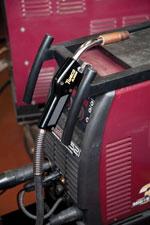
Don’t be tempted to remove the strain relief steel springs to improve maneuverability; doing so risks wire feeding problems.
Before choosing a gun, consider your preferred hand positioning—do you grip the gun like a pistol with the index finger on the trigger, or do you hold it upside down with your thumb on the trigger? Make sure the gun you are considering accommodates your preferred grip style.
More modern guns have longer triggers that allow you to move along the length of the handle for repositioning. This ability to change hand position helps reduce muscle fatigue and repetitive-motion injury. To enhance comfort further in applications with high arc-on time, a dual-schedule trigger will lock in the on position like a toggle until you press it again.
About the Author
Ross Fleischmann
16052 Swingley Ridge Road, Suite 300
St. Louis, MO 63017
800-426-1888
About the Publication
subscribe now

The Welder, formerly known as Practical Welding Today, is a showcase of the real people who make the products we use and work with every day. This magazine has served the welding community in North America well for more than 20 years.
start your free subscription- Stay connected from anywhere

Easily access valuable industry resources now with full access to the digital edition of The Fabricator.

Easily access valuable industry resources now with full access to the digital edition of The Welder.

Easily access valuable industry resources now with full access to the digital edition of The Tube and Pipe Journal.
- Podcasting
- Podcast:
- The Fabricator Podcast
- Published:
- 04/30/2024
- Running Time:
- 53:00
Seth Feldman of Iowa-based Wertzbaugher Services joins The Fabricator Podcast to offer his take as a Gen Zer...
- Trending Articles
Aluminum MIG wires offer smooth feeding, reduced tangling

The role of flux in submerged arc welding performance

Three ESAB welding machines win Red Dot Awards for product design

Power source added to cobot welding system for simplified automation
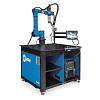
Connecticut students compete in Maritime Welding Competition

- Industry Events
Pipe and Tube Conference
- May 21 - 22, 2024
- Omaha, NE
World-Class Roll Forming Workshop
- June 5 - 6, 2024
- Louisville, KY
Advanced Laser Application Workshop
- June 25 - 27, 2024
- Novi, MI
Precision Press Brake Certificate Course
- July 31 - August 1, 2024
- Elgin,
























